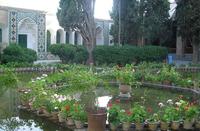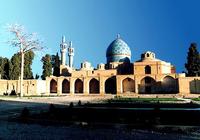Shah Ni‘matu’llah Vali
Shah Ni’matullah Wali Kuhbanani Karam-Banani, Sayyid Nur al-Din (1330-1423/1430/1433), son of Mir ‘Abdullah. Known by the title of ‘Wali’ (‘Friend of God’ or ‘Saint’), he was a leading Sufi master flourishing in the 14th and 15th centuries, and a prolific mystical poet. He founded a Sufi order with a doctrinal approach which influenced Sufis of other orders, as well. He used the noms de plume of Sayyid and Ni’matullah in his ghazals.. His place and date of birth has been reported on the authority of his grandson, Amir Khalil Allah as in Aleppo on Wednesday 26 December 1330, The evidence of those that claim that he was born in the village of Kuhbanan, near Kerman, on Thursday 11 May 1330 is unreliable, since it is conventionally reported that he migrated to that village later on. His father, Mir ‘Abdullah was an Arab notable and his mother was from a family of khans, clan chieftains, from the region of Shabankara in the province of Fars. He was introduced to Sufism at the age of five. The city of Aleppo was the center for Ibn al-‘Arabi’s school of the Unity of Being (wahdat al-wujud) , such that Ni’matullah could be exposed to it at an early age. He eventually went to the land of his mother, Iran, to further his studies, where the city of Shiraz was a pivot of Sunni jurisprudential studies of the Shafi’ite canonical school. He attended Sufi sessions of different orders, seeking, seeking a master, a spiritual guide. At the Shafi’ite seminary he studied the traditional sciences with Shaykh Rukn al-Din Shirazi, rhetoric with Shaykh Shams al-Din Makki, philosophy with Sayyid Jalal al-Din Khwarazmi, and canon law and the principles of jurisprudence with Qazi ‘Azud al-Din Iji (one of the notables later praised by the poet Hafiz). Completing his course of the exoeric sciences, he went on from the intellectual to the spiritual realm, undertaking years of asceticism and self-purification, travelling far and wide in search of a spiritual guide, until he ended up in Mecca, where he attained his goal, becoming initiated by Shaykh ‘Abdullah Yafi’i, one of the greatest mystics of the time, whose disciple he became at the age of 24. His master Yafi’i had inherited six Sufi chains of transmission, including those of the Shadhili and Qadiri orders.
Shah Ni’matullah spent seven years with the Shaykh, undergoing disciplic training and studying the esoteric sciences with him. After a stay in Egypt he returned to the world of Persianate culture, where he spent the rest of his life. He established his first centre in the town of Shahr-i Sabz near Samarkand in the land which was later to become Uzbekistan. Eventually he moved south to Herat, where he married the granddaughter of the noted thinker Mir Husayni Hirawi in Herat, then within a year departed for the southern region of Kerman, settling for a time in the village of Kuhbanan, where he led an ascetic life, training disciples on the Sufi path. [Have omitted reference to name which irrelevant. Have also omitted irrelevant comment on his activity.] He spent much time in composing his works in prose and verse, while humbly engaging in farming as an occupation. .Unlike many religious leaders turning away from the mundane world, he emphasized social activity, working for one’s living, and refraining from indolence. This was important in his programme for the spiritual growth of his disciples, not simply the issuance of moral precepts.
He died in Kerman and was buried in a beautiful garden in the village of Mahan. In 1436 tomb was erected over his grave on the orders of his disciple Ahmad Shah Bahmani, ruler of the Bahmanid kingdom of the Deccan. The tomb complex was expanded with new construction under the Safavid Shah ‘Abbas II (1642-1666). The tombsite is an object of visitation today be Ni’matullahi Sufis. He was succeeded as head of the order by his son, Sayyid Khalil Allah. Shah Ni’matullah’s Divan includes qasidas, ghazals, tarji’s, mathnawis, qit’as and quatrains.
A verse of his reading:
‘We transform the dust of the Way by alchemy;
We cure a hundred ailments with a glance,’
was answered by Hafiz thus:
‘‘Those who transform the dust by alchemy with a glance,
Might they but cast a glance at us?’ ’
His poetry has been compiled in a work entitled Kulliyat-i ash’ar-i Shah Ni’matullah Wali.,His prose works include Risala-yi Istilahat (a glossary of Sufi terminology); Risala-yi Qul Huwa ‘llahu Ahad (mystical exegesis of a Koranic sura); Risala-yi Tawakku (On Trust-in-God)l; Risala-yi Tahqiqat (On Realisation); Mukashafat (Visions); and Adab-i khalwat (On the Procedure of Retreat).
He was a highly productive exponent of of the fundamentals of Sufism, as well as being a seminal thinker in the history of Sufism, enhanced by his influence as a powerful master. His mystical treatises and poetical compositions were too numerous for his followers to amass them in their entirety. Thus, ‘Abd al-Razzaq Kirmani states, ‘No one has been known to have succeeded in collecting all his writings owing to the vast number of his works in prose and verse. Although his splendid output of poetry has been to some extent compiled, many of his compositions are not included in the existing divan. The classical scholar Mawlana Sadid al-Din Nasrullah, has quoted many of his ghazals and other forms of poetry which have not been included therein. His eminent disciple Shah Da’i Shirazi, a spiritual guide in his own right, a Sufi of great gnostic awareness, has written a notable introduction to the master’s divan. In addition, there is a preamble purported to be by another disciple. Indeed, all the pearls in verse and prose [composed by Shah Ni’matullah] are like a single beam of light in the multitude of his luminous emanations – indeed, one drop of the Sea, such that if the sea turned to ink, the collection could never be brought to an end in a single liftetime.’
Quoting a contemporary, he proceeds to state that Kirmani had collected 340 treatises in Damascus and three volumes in India, the latter consistine of 150, 64 and 50 treatises respectively.’ Kirmani identifies 106 of them by their titles. They are in both Persian and Arabic, expounding mystical doctrine in a scholarly style. Ma’sum ‘Ali-Shah Shirazi presents a partial list, giving a precis of the subject-matter of some and quoting a few passages in his Tara’iq al-haqa’iq. The contemporary scholar Sa’id Nafisi gives a more detailed list of the treatises, the majority of which have been published. The number of couplets included in the fullest compendium of the poetry exceeds 13,000 verses in different forms. The diction tends to be straightforward, not especially exalted, and devoid of poetical embellishments, primarily expository, often simply didactic.
Tarikh-i adabiyyat dar Iran (4, 228-233); Dunbala-yi justuju dar tasawwuf (195-200); Tara’iq al-haqa’iq (3, 11-21); Farhang-i sukhanvaran (946-947); Miras-i tasawwuf (1, 471-491).


 In association with The Iran Heritage Foundation © All rights reserved 2025. Jane Lewisohn | Website by
In association with The Iran Heritage Foundation © All rights reserved 2025. Jane Lewisohn | Website by